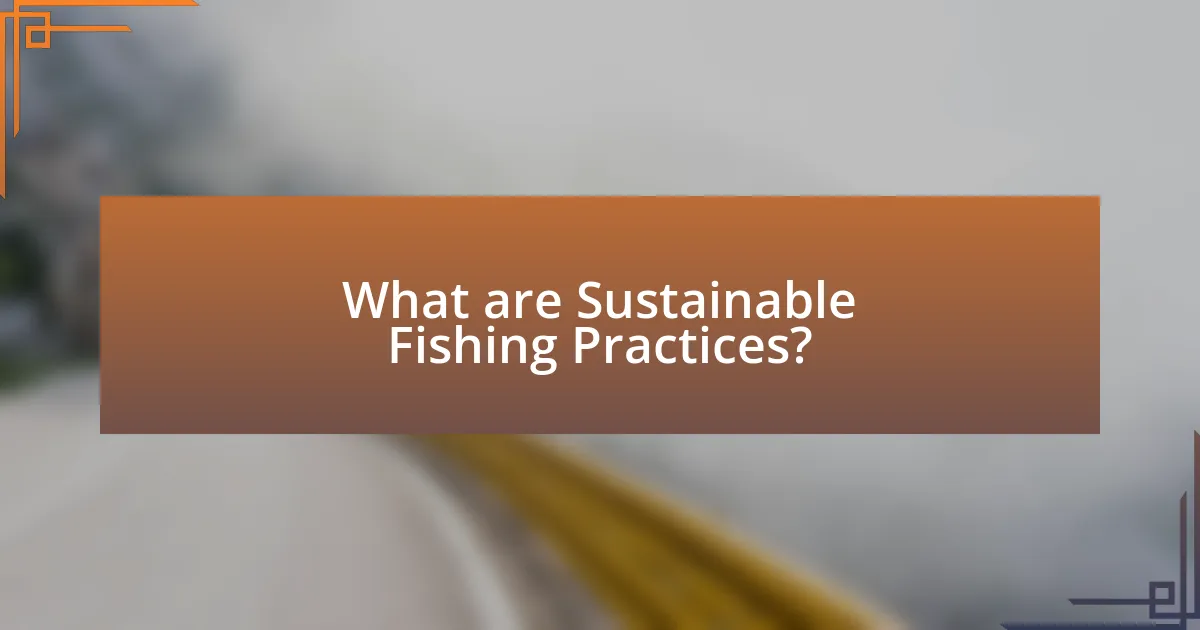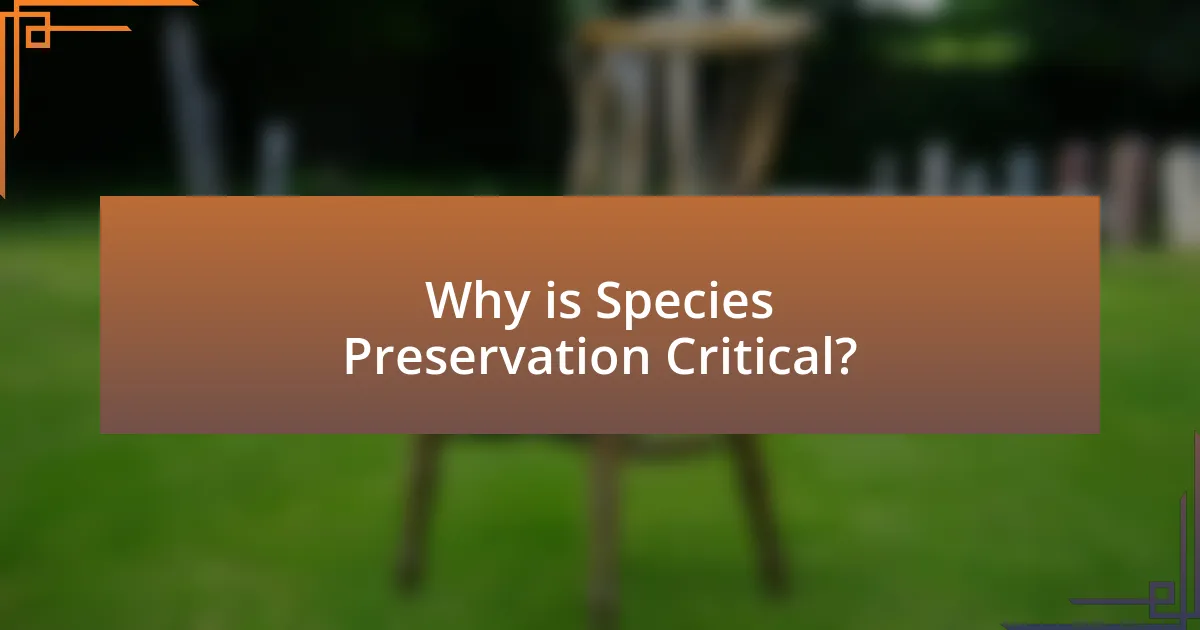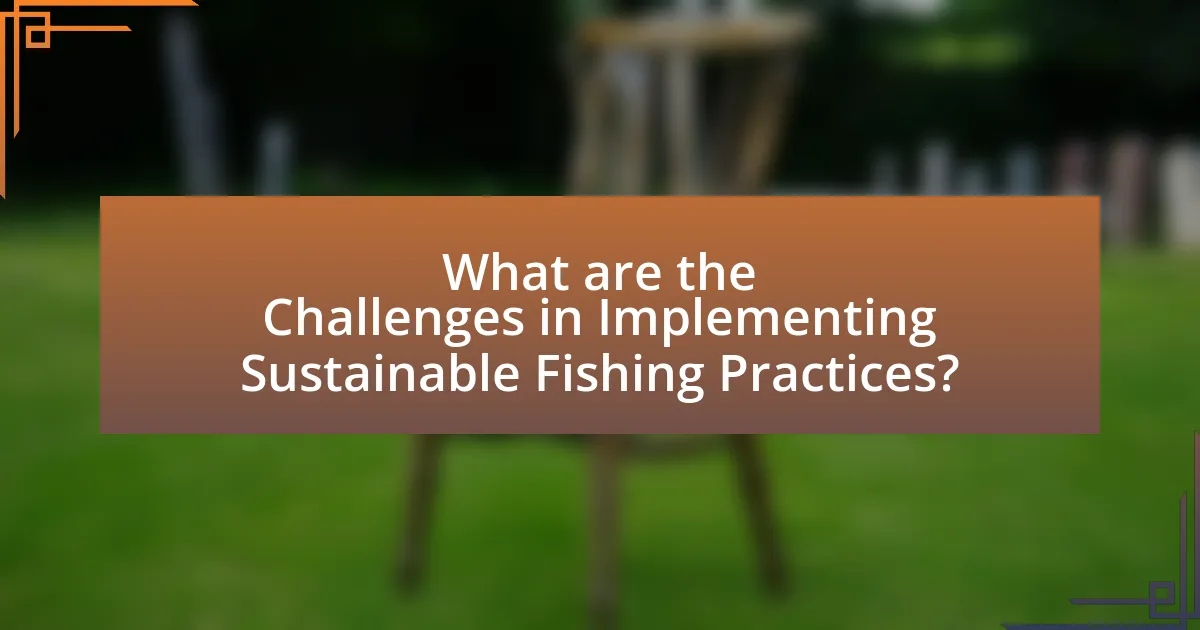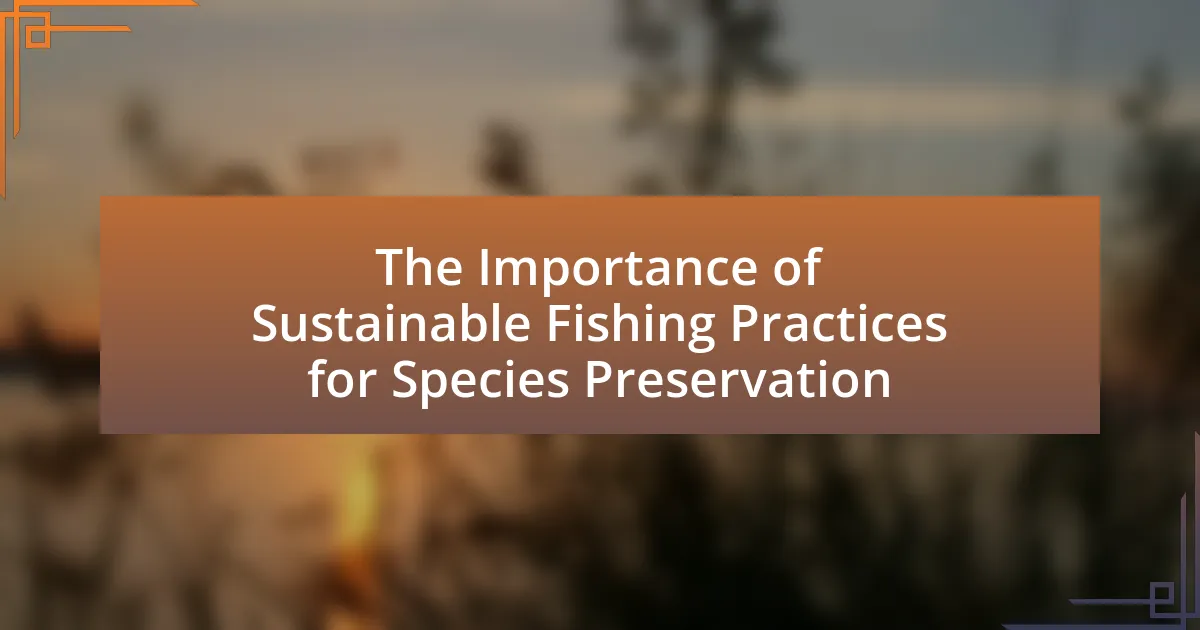Sustainable fishing practices are essential methods aimed at maintaining fish populations and the health of marine ecosystems. This article outlines the differences between sustainable and traditional fishing methods, emphasizing the importance of practices such as catch limits, seasonal closures, and selective gear use in preventing overfishing and preserving biodiversity. It discusses the key principles of sustainable fishing, the role these practices play in species preservation, and the long-term ecological impacts of overfishing. Additionally, the article addresses the challenges faced in implementing sustainable practices, the influence of economic factors, and the role of technology and regulations in promoting sustainability within the fishing industry.

What are Sustainable Fishing Practices?
Sustainable fishing practices are methods of catching fish that maintain fish populations and the health of marine ecosystems. These practices include techniques such as catch limits, seasonal closures, and selective gear use to minimize bycatch and habitat damage. According to the Food and Agriculture Organization, sustainable fishing aims to ensure that fish stocks remain productive and that fishing activities do not harm the environment, thereby supporting long-term ecological balance and species preservation.
How do sustainable fishing practices differ from traditional fishing methods?
Sustainable fishing practices prioritize the long-term health of fish populations and ecosystems, while traditional fishing methods often focus on short-term catch yields without considering environmental impacts. Sustainable practices include measures such as catch limits, seasonal closures, and gear restrictions to minimize bycatch and habitat damage, which are not typically enforced in traditional methods. For example, the Marine Stewardship Council reports that sustainable fisheries have a lower risk of overfishing, with only 34% of global fish stocks classified as overfished compared to higher rates in traditional fishing contexts. This approach aims to ensure that fish populations can replenish and ecosystems remain balanced, contrasting with traditional methods that may lead to depletion and ecological disruption.
What are the key principles of sustainable fishing?
The key principles of sustainable fishing include maintaining fish populations at healthy levels, minimizing environmental impact, and ensuring the livelihoods of fishing communities. Healthy fish populations are crucial for ecosystem balance; overfishing can lead to population collapse, as evidenced by the decline of cod stocks in the North Atlantic. Minimizing environmental impact involves using methods that reduce bycatch and habitat destruction, such as selective fishing gear and marine protected areas. Additionally, sustainable fishing practices support the economic stability of fishing communities by promoting responsible management and equitable resource distribution, which is essential for long-term viability.
Why is it important to adopt sustainable fishing practices?
Adopting sustainable fishing practices is crucial for maintaining fish populations and preserving marine ecosystems. These practices help prevent overfishing, which can lead to the depletion of fish stocks and disrupt the balance of marine life. For instance, according to the Food and Agriculture Organization (FAO), approximately 34% of global fish stocks are overfished, which threatens biodiversity and the livelihoods of communities that depend on fishing. Sustainable practices, such as catch limits and selective fishing gear, ensure that fish populations can regenerate, thereby supporting long-term ecological health and economic stability.
What role do sustainable fishing practices play in species preservation?
Sustainable fishing practices play a crucial role in species preservation by ensuring that fish populations are harvested at a rate that allows them to replenish. These practices, such as catch limits, seasonal closures, and selective gear use, help maintain the balance of marine ecosystems. For instance, according to the Food and Agriculture Organization, sustainable fisheries management can lead to a 20% increase in fish stocks, which directly supports biodiversity and the health of marine habitats. By reducing overfishing and minimizing bycatch, sustainable fishing practices contribute to the long-term viability of various species, thereby enhancing overall marine biodiversity.
How do these practices help maintain fish populations?
Sustainable fishing practices help maintain fish populations by ensuring that fish are harvested at a rate that allows their populations to replenish. These practices include measures such as catch limits, seasonal closures, and gear restrictions, which prevent overfishing and protect breeding stocks. For example, the implementation of catch limits based on scientific assessments has been shown to lead to population recovery in species like the Atlantic cod, which saw a significant increase in biomass after regulations were enforced. Additionally, marine protected areas (MPAs) contribute to population stability by providing safe habitats where fish can grow and reproduce without the pressure of fishing.
What impact do sustainable practices have on marine ecosystems?
Sustainable practices positively impact marine ecosystems by promoting biodiversity and reducing overfishing. These practices, such as catch limits and habitat protection, help maintain fish populations and the overall health of marine environments. For instance, the implementation of sustainable fishing regulations has led to a 20% increase in fish stocks in regions where they are enforced, as reported by the Food and Agriculture Organization. This increase supports not only the species targeted for fishing but also the entire marine food web, enhancing ecosystem resilience and stability.

Why is Species Preservation Critical?
Species preservation is critical because it maintains biodiversity, which is essential for ecosystem stability and resilience. Biodiversity supports ecosystem services such as pollination, nutrient cycling, and climate regulation, which are vital for human survival. For instance, a study published in the journal “Nature” found that ecosystems with higher species diversity are more productive and better able to withstand environmental stressors. Additionally, preserving species helps prevent the loss of genetic diversity, which is crucial for adapting to changing environments and combating diseases. Thus, species preservation directly impacts ecological health and human well-being.
What are the consequences of overfishing on species diversity?
Overfishing significantly reduces species diversity by depleting fish populations and disrupting marine ecosystems. When specific species are overfished, it leads to imbalances in the food web, causing declines in predator and prey relationships. For instance, the collapse of cod stocks in the North Atlantic has resulted in increased populations of smaller fish and invertebrates, which alters the entire ecosystem structure. Additionally, overfishing can lead to the extinction of vulnerable species, further diminishing biodiversity. According to the Food and Agriculture Organization, approximately 34% of global fish stocks are overfished, highlighting the urgent need for sustainable fishing practices to preserve species diversity.
How does overfishing affect the food chain?
Overfishing disrupts the food chain by depleting key fish populations, which serve as both predators and prey within marine ecosystems. When overfishing occurs, the removal of large numbers of fish can lead to an imbalance, causing a decline in species that rely on those fish for food. For example, the overfishing of sardines can reduce the food supply for larger predators like seals and seabirds, ultimately affecting their populations. Additionally, the loss of certain fish species can lead to an increase in their prey, such as smaller fish or invertebrates, which can further alter the ecosystem dynamics. Studies have shown that overfishing can lead to a 50% reduction in fish populations, significantly impacting the entire marine food web.
What are the long-term effects of species extinction on marine environments?
Species extinction has profound long-term effects on marine environments, leading to decreased biodiversity, disrupted food webs, and altered ecosystem functions. The loss of key species, such as top predators or keystone species, can result in overpopulation of certain organisms, which may cause habitat degradation and a decline in overall ecosystem health. For instance, the extinction of large fish species can lead to an increase in smaller fish populations, which may overgraze on essential habitats like coral reefs, ultimately leading to their collapse. Research indicates that ecosystems with higher biodiversity are more resilient to changes and disturbances, emphasizing the critical role that species preservation plays in maintaining marine health.
How do sustainable fishing practices contribute to biodiversity?
Sustainable fishing practices contribute to biodiversity by ensuring that fish populations are harvested at a rate that allows them to replenish, thereby maintaining ecosystem balance. These practices, such as catch limits, selective fishing gear, and protected marine areas, help prevent overfishing and habitat destruction, which are critical threats to marine biodiversity. For instance, according to the Food and Agriculture Organization, sustainable fisheries management can lead to a 20% increase in fish stocks, which supports not only the targeted species but also the entire food web, including predators and prey. This holistic approach fosters resilience in marine ecosystems, allowing diverse species to thrive and adapt to environmental changes.
What specific species benefit from sustainable fishing efforts?
Specific species that benefit from sustainable fishing efforts include Atlantic cod, Pacific salmon, and bluefin tuna. These species experience population recovery and stability due to regulated catch limits, habitat protection, and responsible fishing practices. For instance, the implementation of catch shares in the U.S. has led to a significant increase in the biomass of Atlantic cod, demonstrating the effectiveness of sustainable practices in enhancing fish populations.
How do these practices support the recovery of endangered species?
Sustainable fishing practices support the recovery of endangered species by reducing overfishing and minimizing bycatch, which allows fish populations to replenish. For instance, implementing catch limits and seasonal closures helps maintain fish stocks at sustainable levels, as evidenced by the recovery of the North Atlantic cod, which saw population increases after the introduction of strict fishing regulations. Additionally, practices such as selective gear use reduce the unintended capture of non-target species, thereby protecting vulnerable marine life and promoting biodiversity.

What are the Challenges in Implementing Sustainable Fishing Practices?
The challenges in implementing sustainable fishing practices include economic pressures, regulatory complexities, and social resistance. Economic pressures arise as many fishing communities rely on traditional fishing methods that may not align with sustainability goals, leading to conflicts between livelihoods and conservation efforts. Regulatory complexities often stem from the need for comprehensive policies that can be difficult to enforce, especially in international waters where jurisdiction is unclear. Social resistance can occur when local communities perceive sustainable practices as threats to their cultural heritage or economic stability. These challenges hinder the effective adoption of practices that are crucial for preserving fish populations and marine ecosystems.
What barriers do fishermen face in adopting sustainable methods?
Fishermen face several barriers in adopting sustainable methods, primarily including economic constraints, lack of access to information, and regulatory challenges. Economic constraints arise from the higher initial costs associated with sustainable practices, which can deter fishermen who operate on tight margins. A study by the Food and Agriculture Organization (FAO) highlights that many small-scale fishermen lack the financial resources to invest in sustainable technologies or practices, leading to a reliance on traditional, less sustainable methods.
Additionally, a lack of access to information about sustainable practices and their long-term benefits can hinder adoption. Many fishermen may not be aware of the advantages of sustainable fishing or how to implement these methods effectively. Research published in the journal “Fisheries Research” indicates that educational outreach and training programs are often insufficient, leaving fishermen without the necessary knowledge to transition to sustainable practices.
Regulatory challenges also play a significant role, as existing fishing regulations may not support or incentivize sustainable methods. In some regions, policies may favor industrial fishing practices over small-scale sustainable approaches, creating an uneven playing field. The World Bank has reported that inconsistent regulations can create confusion and discourage fishermen from adopting new methods, as they may fear non-compliance or penalties.
How do economic factors influence fishing practices?
Economic factors significantly influence fishing practices by determining the profitability and sustainability of fishing activities. For instance, fluctuations in fish prices can lead to overfishing as fishermen seek to maximize short-term profits, often disregarding long-term ecological impacts. According to the Food and Agriculture Organization, the global fish market was valued at approximately $401 billion in 2020, highlighting the economic incentives that drive fishing practices. Additionally, subsidies provided by governments can encourage unsustainable practices by making it financially viable to fish in overexploited areas. This economic pressure can lead to the depletion of fish stocks, threatening species preservation and marine biodiversity.
What role do regulations play in promoting sustainable fishing?
Regulations play a crucial role in promoting sustainable fishing by establishing guidelines that limit overfishing and protect marine ecosystems. These regulations often include catch limits, size restrictions, and seasonal closures, which help maintain fish populations at sustainable levels. For instance, the Magnuson-Stevens Fishery Conservation and Management Act in the United States has been instrumental in rebuilding overfished stocks, demonstrating that effective regulatory frameworks can lead to recovery and sustainability in fisheries. Additionally, regulations can enforce habitat protection measures, ensuring that critical ecosystems are preserved, which further supports the long-term viability of fish species.
How can technology aid in sustainable fishing practices?
Technology can aid in sustainable fishing practices by providing tools for monitoring fish populations and improving catch efficiency while minimizing environmental impact. For instance, satellite tracking and sonar technology enable fishers to locate schools of fish without overfishing specific areas, thus preserving marine ecosystems. Additionally, data analytics and machine learning can analyze historical catch data to predict fish migration patterns, allowing for better management of fishing quotas. According to a study published in the journal “Nature,” the use of electronic monitoring systems has shown a 20% reduction in bycatch, which is crucial for protecting non-target species. These technological advancements not only enhance the sustainability of fishing practices but also contribute to the long-term health of marine biodiversity.
What innovations are currently being used in sustainable fishing?
Innovations currently being used in sustainable fishing include the development of advanced tracking technologies, such as satellite monitoring and GPS-enabled devices, which help in managing fish stocks and preventing overfishing. These technologies allow for real-time data collection on fish populations and fishing activities, enabling better regulatory compliance and conservation efforts. Additionally, the implementation of selective fishing gear, such as circle hooks and fish traps, minimizes bycatch and protects non-target species. Research indicates that these innovations contribute to healthier marine ecosystems and support the long-term viability of fish populations, as evidenced by studies showing a reduction in bycatch rates and improved fish stock recovery in regions where such practices are adopted.
How can data collection improve fishing sustainability?
Data collection can improve fishing sustainability by providing accurate information on fish populations, habitats, and ecosystem health. This data enables fisheries managers to make informed decisions regarding catch limits, seasonal closures, and protected areas, which are essential for maintaining fish stocks. For instance, the use of satellite technology and fishery-independent surveys has shown that regions with data-driven management practices have seen a 20% increase in fish populations over a decade, according to a study published in the journal “Fish and Fisheries.” By continuously monitoring and analyzing data, stakeholders can adapt their strategies to changing environmental conditions, ensuring long-term sustainability of fish resources.
What are some best practices for sustainable fishing?
Best practices for sustainable fishing include implementing catch limits, using selective gear, and protecting habitats. Catch limits ensure that fish populations remain healthy by preventing overfishing; for example, the Magnuson-Stevens Fishery Conservation and Management Act in the U.S. sets annual catch limits based on scientific assessments. Selective gear, such as circle hooks and fish traps, reduces bycatch, which is the unintended capture of non-target species, thereby preserving biodiversity. Additionally, protecting critical habitats like spawning grounds and nursery areas is essential for maintaining fish populations, as demonstrated by the establishment of marine protected areas that have shown increased fish stocks and biodiversity.
How can consumers support sustainable fishing initiatives?
Consumers can support sustainable fishing initiatives by choosing seafood that is certified by reputable organizations, such as the Marine Stewardship Council (MSC) or the Aquaculture Stewardship Council (ASC). These certifications indicate that the seafood is sourced from fisheries or farms that adhere to sustainable practices, which help preserve fish populations and marine ecosystems. According to a 2021 report by the Food and Agriculture Organization (FAO), sustainable fishing practices can significantly reduce overfishing and promote biodiversity, making informed purchasing decisions crucial for consumers who wish to contribute to these efforts.
What organizations are leading the way in sustainable fishing practices?
The organizations leading the way in sustainable fishing practices include the Marine Stewardship Council (MSC), the World Wildlife Fund (WWF), and the Food and Agriculture Organization (FAO). The Marine Stewardship Council sets standards for sustainable fishing and certifies fisheries that meet these criteria, promoting responsible fishing practices globally. The World Wildlife Fund works on various initiatives to protect marine ecosystems and advocates for sustainable seafood sourcing. The Food and Agriculture Organization provides guidelines and support for sustainable fisheries management, emphasizing the importance of maintaining fish populations and habitats. These organizations collectively contribute to the preservation of marine species and ecosystems through their efforts in promoting sustainable fishing practices.
